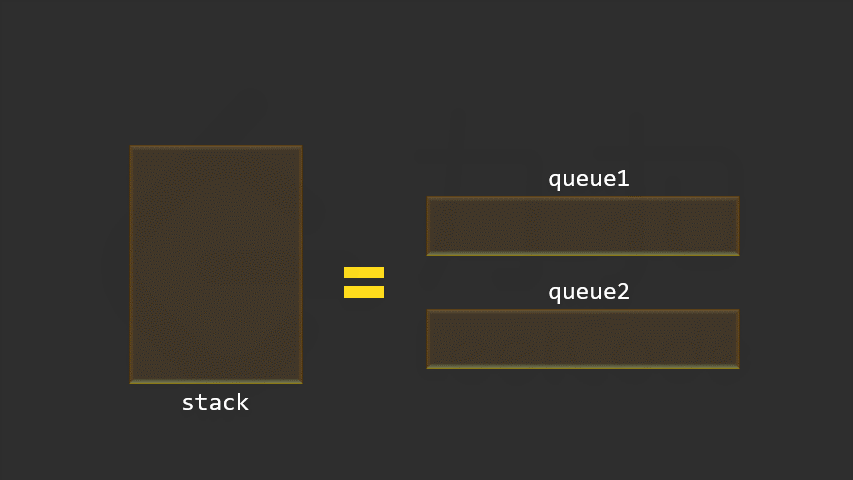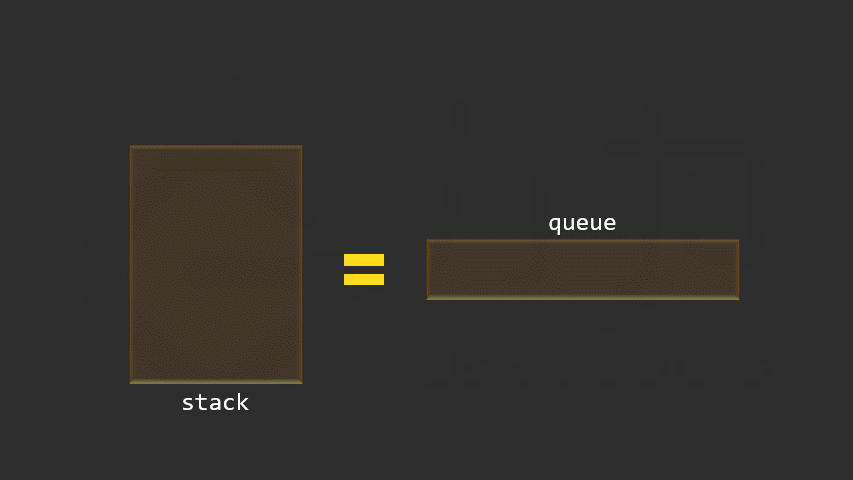最初写的
1 2 3 4 5 6 7 8 9 10 11 12 13 14 15 16 17 18 19 20 21 22 23 24 25 26 27 28 29 30 31 32 33 34 35 36 37 38 val stack = Stack<Int >() val tempStack = Stack<Int >() fun push (x: Int ) stack.push(x) } fun pop () Int { while (!stack.empty()) { tempStack.push(stack.pop()) } var pop = 0 if (!tempStack.isEmpty()) { pop = tempStack.pop() } while (!tempStack.empty()) { stack.push(tempStack.pop()) } return pop } fun peek () Int { while (!stack.empty()) { tempStack.push(stack.pop()) } var peek = 0 if (!tempStack.isEmpty()) { peek = tempStack.peek() } while (!tempStack.empty()) { stack.push(tempStack.pop()) } return peek } fun empty () Boolean { return stack.empty() }
在LC232基础上进行的优化,之前每次pop后,还得把元素放回去,这里只有push判断 tempStack有没有元素
https://leetcode.cn/problems/implement-queue-using-stacks/solution/wen-zi-shi-pin-de-fang-shi-xiang-xi-jiang-jie-li-2/
1 2 3 4 5 6 7 8 9 10 11 12 13 14 15 16 17 18 19 20 21 22 23 24 25 26 27 28 29 30 val stackIn = Stack<Int >() val tempStack = Stack<Int >() fun push (x: Int ) while (!tempStack.empty()){ stackIn.push(tempStack.pop()) } stackIn.push(x) } fun pop () Int { while (!stackIn.empty()) { tempStack.push(stackIn.pop()) } var pop = -1 if (!tempStack.isEmpty()) { pop = tempStack.pop() } return pop } fun peek () Int { val pop = this .pop() stackIn.push(pop) return pop } fun empty () Boolean { return tempStack.empty()&&stackIn.empty() }
随想录写法
https://programmercarl.com/0232.%E7%94%A8%E6%A0%88%E5%AE%9E%E7%8E%B0%E9%98%9F%E5%88%97.html#%E5%85%B6%E4%BB%96%E8%AF%AD%E8%A8%80%E7%89%88%E6%9C%AC
在LC232_01基础上进行的优化,push的时候不用每次都判断,只有stackOut是空的时候,才需要取后面的元素
1 2 3 4 5 6 7 8 9 10 11 12 13 14 15 16 17 18 19 20 21 22 23 24 25 26 27 28 29 private val stackIn = Stack<Int >() private val stackOut = Stack<Int >() fun push (x: Int ) stackIn.push(x) } fun pop () Int { if (stackOut.isEmpty()) { while (!stackIn.empty()) { stackOut.push(stackIn.pop()) } } var data = -1 if (!stackOut.isEmpty()) { data = stackOut.pop() } return data } fun peek () Int { val pop = this .pop() stackOut.push(pop) return pop } fun empty () Boolean { return stackOut.empty() && stackIn.empty() }
我的解法 1 2 3 4 5 6 7 8 9 10 11 12 13 14 15 16 17 18 19 20 21 22 23 24 25 26 27 28 29 30 31 32 33 34 35 36 private val mainDeque = ArrayDeque<Int >()private val tempDeque = ArrayDeque<Int >()fun push (x: Int ) while (!tempDeque.isEmpty()) { mainDeque.offerLast(tempDeque.poll()) } mainDeque.offerLast(x) } fun pop () Int { var data = -1 while (!mainDeque.isEmpty()) { if (mainDeque.size == 1 ) { data = mainDeque.poll() } else { data = mainDeque.poll() tempDeque.offerLast(data ) } } while (!tempDeque.isEmpty()) { mainDeque.offerLast(tempDeque.poll()) } return data } fun top () Int { val pop = this .pop() mainDeque.offerLast(pop) return pop } fun empty () Boolean { return tempDeque.isEmpty() && mainDeque.isEmpty() }
两个队列 https://programmercarl.com/0225.%E7%94%A8%E9%98%9F%E5%88%97%E5%AE%9E%E7%8E%B0%E6%A0%88.html
https://leetcode.cn/problems/implement-stack-using-queues/solution/yong-dui-lie-shi-xian-zhan-by-leetcode-solution/
这里的视频教程更好理解.
1 2 3 4 5 6 7 8 9 10 11 12 13 14 15 16 17 18 19 20 21 22 23 24 25 26 private var mainDeque = LinkedList<Int >()private var tempDeque = LinkedList<Int >()fun push (x: Int ) tempDeque.offer(x) while (!mainDeque.isEmpty()) { tempDeque.offerLast(mainDeque.poll()) } val temp = mainDeque mainDeque = tempDeque tempDeque = temp } fun pop () Int { return mainDeque.poll() } fun top () Int { return mainDeque.peek() } fun empty () Boolean { return tempDeque.isEmpty() && mainDeque.isEmpty() }
一个队列 也是上面官方教程
1 2 3 4 5 6 7 8 9 10 11 12 13 14 15 16 17 18 19 20 private var mainDeque = LinkedList<Int >()fun push (x: Int ) mainDeque.offer(x) for (i in 0 until mainDeque.size - 1 ) { mainDeque.offer(mainDeque.poll()) } } fun pop () Int { return mainDeque.poll() } fun top () Int { return mainDeque.peek() } fun empty () Boolean { return mainDeque.isEmpty() }
1 2 3 4 5 6 7 8 9 10 11 12 13 14 15 val queue = LinkedList<Int >()queue.offer(0 ) queue.offer(1 ) queue.offer(2 ) queue.offer(3 ) for (i in 0 until queue.size - 1 ) { queue.offer(queue.poll()) println(queue) }
1 2 3 4 5 6 7 8 9 10 11 12 fun isValid (s: String ) Boolean { val mapOf = mapOf('(' to ')' , '{' to '}' , '[' to ']' ) val stack = Stack<Char >() s.chars().forEach { if (!stack.empty() && mapOf[stack.peek()] == it.toChar()) { stack.pop() } else { stack.push(it.toChar()) } } return stack.empty() }
而且在企业项目开发中,尽量不要使用递归! 在项目比较大的时候,由于参数多,全局变量等等,使用递归很容易判断不充分return的条件,非常容易无限递归(或者递归层级过深),造成栈溢出错误(这种问题还不好排查!)
1 2 3 4 5 6 7 8 9 10 11 fun removeDuplicates (s: String ) val stack = Stack<Char >() s.chars().forEach { if (!stack.empty()&&stack.peek()==it.toChar()){ stack.pop() }else { stack.push(it.toChar()) } } return stack.joinToString(separator = "" ) }
1 2 3 4 5 6 7 8 9 10 11 12 13 14 15 16 17 18 19 20 21 22 23 24 25 26 fun evalRPN (tokens: Array <String >) Int { val stack = Stack<Int >() tokens.forEach { if (it == "+" || it == "-" || it == "*" || it == "/" ) { val pop1 = stack.takeUnless { p1 -> p1.empty() }?.pop() val pop2 = stack.takeUnless { p2 -> p2.empty() }?.pop() if (pop1 != null && pop2 != null ) { val result = getResult(it, pop2.toInt(), pop1.toInt()) stack.push(result) } } else { stack.push(it.toInt()) } } return stack.peek() } private fun getResult (operator : String , pop1: Int , pop2: Int ) Int { return when (operator ) { "+" -> pop1 + pop2 "-" -> pop1 - pop2 "*" -> pop1 * pop2 "/" -> pop1 / pop2 else -> throw RuntimeException("oh something went wrong" ) } }
存储元素坐标 https://programmercarl.com/0239.%E6%BB%91%E5%8A%A8%E7%AA%97%E5%8F%A3%E6%9C%80%E5%A4%A7%E5%80%BC.html
nums[index - k]是队列头部最大元素,此时最大元素出队列,因为最大元素一定改窗口的最左侧元素,
如果不是最大元素,因为滑动窗口可能没有k个元素,也不用担心是不是留在窗口里,这种情况下其实在下面push已经早出去了
这样更好理解 移动窗口,队列头结点需要在[i - k + 1, i]范围内,不符合则要弹出
这种也是官方解法
1 2 3 4 5 6 7 8 9 10 11 12 13 14 15 16 17 18 fun maxSlidingWindow2 (nums: IntArray , k: Int ) val linkedList = LinkedList<Int >() val resultArray = IntArray(nums.size - (k - 1 )) var i = 0 nums.forEachIndexed { index, value -> if (!linkedList.isEmpty() && linkedList.peek() < index - (k - 1 )) { linkedList.pop() } while (!linkedList.isEmpty() && value > nums[linkedList.last()]) { linkedList.removeLast() } linkedList.offer(index) if (index >= (k - 1 )) { resultArray[i++] = nums[linkedList.peek()] } } return resultArray }
https://leetcode.cn/problems/sliding-window-maximum/solution/hua-dong-chuang-kou-de-zui-da-zhi-bao-mu-9eci/
MyQueue 随想录定义Myquue,更好,单一指责,更有层次感
// 注意先将前k的元素放进队列,此时push方法,放完后已经是按照单调递减队列来的了
二刷来刷刷刷
大顶堆 看官方题解理解了
但是大顶堆 小顶堆区别不是很明白,学完树再来继续做这个题目


